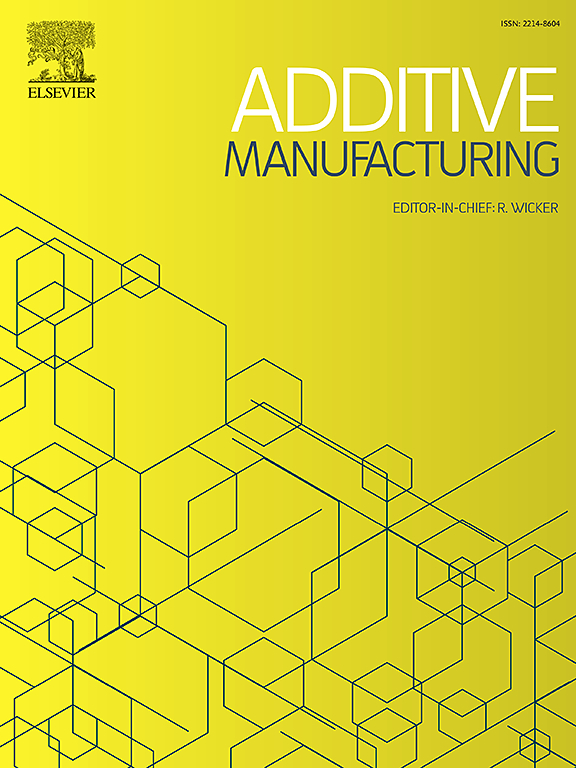Modulation-enabled healable and stretchable shape-memory polymer composites for digital light processing 4D printing
IF 10.3
1区 工程技术
Q1 ENGINEERING, MANUFACTURING
引用次数: 0
Abstract
4D printing provides viable pathways for 3D-printed objects that require morphological, time-dependent adaptations. Among various 4D printing materials, shape-memory polymers (SMPs) are one of the most extensively utilized morphing materials. However, most existing SMPs in 4D printing systems suffer from irreparability and low stretchability due to abundant covalently cross-linked networks. Also, their shape-programming steps typically involve stringent temperature requirements (≥90 ºC) and lack strategies for remote controllability, significantly restricting their applicability. Herein, we report a novel thermoplastic polymer system with self-healing and highly stretchable shape-memory capabilities for digital light processing (DLP)-based 4D printing. This system was attained through the integration of two distinct compositions: a polymer-based framework that acts as the reinforcing phase; and an elastic lubricant featuring hydrogen bonds that facilitates self-healing, high stretchability, and enhanced shape recovery. Additionally, light-responsive capabilities were shown to be effectively achieved by introducing a novel cross-linker functionalized with biomass lignin. The rationally selected safer set of ingredients ensures that our printed shape-memory polymer composites (SMPCs) are biocompatible. We further demonstrate their potential applications in aerospace and healthcare. This work provides a foundation for the design and facilitation of intelligent materials, showcasing excellent properties across multiple fields.
调制支持可愈合和可拉伸的形状记忆聚合物复合材料,用于数字光处理4D打印
4D打印为需要形态、时间依赖性适应的3d打印对象提供了可行的途径。在各种4D打印材料中,形状记忆聚合物(SMPs)是应用最广泛的变形材料之一。然而,由于大量的共价交联网络,大多数现有的4D打印系统中的smp存在不可修复性和低拉伸性。此外,它们的形状编程步骤通常涉及严格的温度要求(≥90ºC),并且缺乏远程控制策略,这大大限制了它们的适用性。在此,我们报告了一种具有自我修复和高度可拉伸形状记忆能力的新型热塑性聚合物系统,用于基于数字光处理(DLP)的4D打印。该系统是通过整合两种不同的组合物来实现的:基于聚合物的框架作为增强相;一种具有氢键的弹性润滑剂,有助于自我修复,高拉伸性和增强形状恢复。此外,通过引入一种以生物质木质素为功能化的新型交联剂,可以有效地实现光响应能力。合理选择更安全的一组成分确保我们的打印形状记忆聚合物复合材料(SMPCs)具有生物相容性。我们进一步展示了它们在航空航天和医疗保健领域的潜在应用。这项工作为智能材料的设计和促进提供了基础,在多个领域展示了优异的性能。
本文章由计算机程序翻译,如有差异,请以英文原文为准。
求助全文
约1分钟内获得全文
求助全文
来源期刊

Additive manufacturing
Materials Science-General Materials Science
CiteScore
19.80
自引率
12.70%
发文量
648
审稿时长
35 days
期刊介绍:
Additive Manufacturing stands as a peer-reviewed journal dedicated to delivering high-quality research papers and reviews in the field of additive manufacturing, serving both academia and industry leaders. The journal's objective is to recognize the innovative essence of additive manufacturing and its diverse applications, providing a comprehensive overview of current developments and future prospects.
The transformative potential of additive manufacturing technologies in product design and manufacturing is poised to disrupt traditional approaches. In response to this paradigm shift, a distinctive and comprehensive publication outlet was essential. Additive Manufacturing fulfills this need, offering a platform for engineers, materials scientists, and practitioners across academia and various industries to document and share innovations in these evolving technologies.
 求助内容:
求助内容: 应助结果提醒方式:
应助结果提醒方式:


